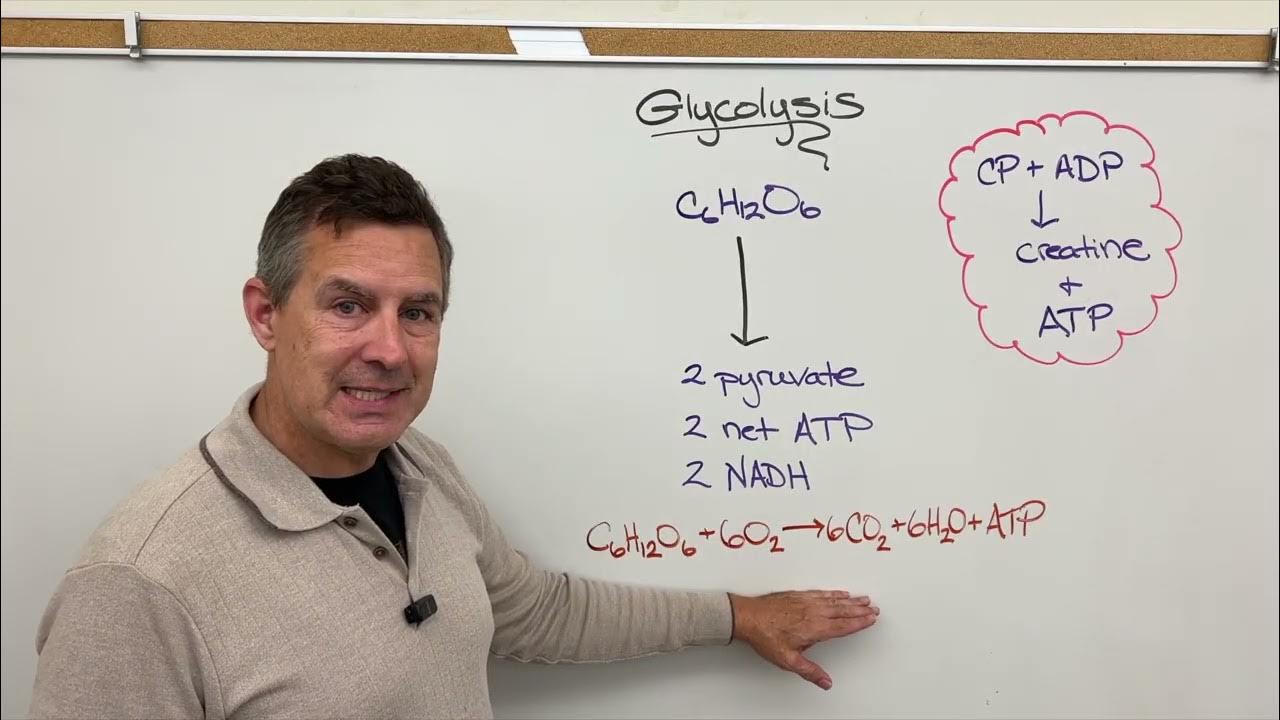Cellular Respiration 5 - Oxidative Phosphorylation
Summary
TLDRThis video explains oxidative phosphorylation, or the electron transport chain, a critical process in cellular respiration. It details the roles of key mitochondrial protein complexes—Complexes I, II, III, IV, and ATP Synthase—in generating ATP. NADH and FADH2 donate electrons, which move through the complexes, pumping protons to create a gradient. The protons then flow through ATP Synthase, driving ATP production. The video highlights the importance of oxygen in this process and provides specific figures for ATP generated per NADH and FADH2. It concludes with a call to support further educational content.
Takeaways
- 😀 The video covers oxidative phosphorylation, also known as the electron transport chain, which occurs in the inner mitochondrial membrane.
- 😀 Mitochondria have an outer and inner membrane, with protein complexes embedded in the inner membrane that play a crucial role in ATP production.
- 😀 The major protein complexes in the electron transport chain are Complex 1 (NADH dehydrogenase), Complex 2 (succinate dehydrogenase), Complex 3 (cytochrome c reductase), and Complex 4 (cytochrome c oxidase).
- 😀 Coenzyme Q-10 and cytochrome c are also involved in the electron transport chain as key electron carriers.
- 😀 ATP synthase, another major protein complex, is responsible for the production of ATP by utilizing the proton gradient generated during electron transport.
- 😀 NADH, produced from glycolysis, beta oxidation, and the TCA cycle, donates electrons to the electron transport chain, which eventually leads to the formation of water.
- 😀 Oxygen, supplied by breathing, accepts the electrons and protons at the end of the electron transport chain, forming water and making breathing essential for animals.
- 😀 As electrons move through the complexes, they pump protons across the mitochondrial membrane, creating a proton gradient.
- 😀 Complex 1 pumps 4 protons, Complex 3 pumps 4 protons, and Complex 4 pumps 2 protons per NADH molecule, leading to a total of 10 protons being pumped across the membrane.
- 😀 When FADH2 is the electron donor, only 6 protons are pumped across the membrane because it bypasses Complex 1.
- 😀 Protons flow back through ATP synthase, and for every 4 protons that pass through, one ATP molecule is produced.
- 😀 According to the textbook 'Principles of Biochemistry' (5th edition), 1 NADH results in the production of 2.5 ATP, and 1 FADH2 results in the production of 1.5 ATP.
Q & A
What is oxidative phosphorylation?
-Oxidative phosphorylation is the final stage of cellular respiration, occurring in the mitochondria, where ATP is produced through the electron transport chain and chemiosmosis.
What role do the protein complexes in the inner mitochondrial membrane play?
-The protein complexes (Complex I, II, III, and IV) in the inner mitochondrial membrane facilitate the transfer of electrons in the electron transport chain, which helps generate a proton gradient used to synthesize ATP.
How does NADH contribute to the electron transport chain?
-NADH donates electrons to Complex I, which are passed through the electron transport chain, ultimately leading to the production of ATP and water, with protons pumped across the membrane.
What is the role of oxygen in the electron transport chain?
-Oxygen acts as the final electron acceptor in the electron transport chain. It combines with electrons and protons to form water, ensuring the continuation of the chain.
Why is ATP synthase important in oxidative phosphorylation?
-ATP synthase is responsible for converting the energy from the proton gradient into ATP by allowing protons to flow back into the mitochondrial matrix, driving the production of ATP.
How many protons are pumped across the membrane by NADH?
-Each NADH molecule pumps 10 protons across the inner mitochondrial membrane: 4 from Complex I, 4 from Complex III, and 2 from Complex IV.
What happens when FADH2 is used instead of NADH?
-When FADH2 donates electrons, it enters the electron transport chain at Complex II, bypassing Complex I. As a result, fewer protons are pumped across the membrane, leading to the production of less ATP (1.5 ATP per FADH2).
What is the proton gradient, and why is it important?
-The proton gradient is created by pumping protons from the mitochondrial matrix to the intermembrane space. This gradient stores potential energy, which is used by ATP synthase to produce ATP when protons flow back through the enzyme.
How much ATP is generated by one NADH molecule?
-One NADH molecule generates approximately 2.5 ATP molecules during oxidative phosphorylation.
Why do different textbooks report varying ATP yields from NADH and FADH2?
-Different textbooks may use slightly different assumptions or models for ATP production, such as variations in proton pumping efficiency or other factors, which can lead to variations in reported ATP yields.
Outlines

Esta sección está disponible solo para usuarios con suscripción. Por favor, mejora tu plan para acceder a esta parte.
Mejorar ahoraMindmap

Esta sección está disponible solo para usuarios con suscripción. Por favor, mejora tu plan para acceder a esta parte.
Mejorar ahoraKeywords

Esta sección está disponible solo para usuarios con suscripción. Por favor, mejora tu plan para acceder a esta parte.
Mejorar ahoraHighlights

Esta sección está disponible solo para usuarios con suscripción. Por favor, mejora tu plan para acceder a esta parte.
Mejorar ahoraTranscripts

Esta sección está disponible solo para usuarios con suscripción. Por favor, mejora tu plan para acceder a esta parte.
Mejorar ahoraVer Más Videos Relacionados

AP Bio - Cellular Respiration - Part 1

Cellular Respiration

Introduction to cellular respiration | Cellular respiration | Biology | Khan Academy

AP Biology: Aerobic Respiration

Cellular Respiration (Electron Transport Chain) - animated

Cellular Respiration Part 3: The Electron Transport Chain and Oxidative Phosphorylation
5.0 / 5 (0 votes)
